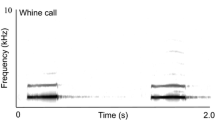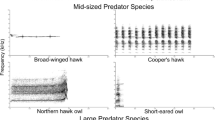Summary
Auditory tuning curves of a small songbird, the great tit (Parus major), and of its principal avian predator, the European sparrowhawk (Accipiter nisus), were determined by an operant positive reinforcement conditioning procedure, using the method of constant stimuli. Thresholds were measured by the criterion of a 50% correct response and a d′ of 1.5 for intra- and interspecific comparison, respectively. The best frequency of both species was 2 kHz, the hawk being 6.5 dB SPL more sensitive than the tit. Although the high-frequency cutoff was very similar in both species, at 8 kHz the great tit was about 30 dB more sensitive than the sparrowhawk. The hearing abilities of the prey and its predator are discussed with reference to the acoustic alarm communication of great tits confronted with sparrowhawks. Two alarm calls lie in the frequency range of the best hearing of both the hawk and the tits: the mobbing call and a call given in response to a nearby hawk when fleeing from it. In contrast, the “seeet” call, an alarm call given mainly in response to distant flying sparrowhawks, can only be heard well by the tit. The implications of these results for hypotheses concerning the evolution of alarm calls in small songbirds are discussed.
Similar content being viewed by others
References
Brenowitz EA (1982) The active space of Red-winged Blackbird song. J Comp Physiol 147:511–522
Brown CH (1982) Ventriloquial and locatable vocalizations in birds. Z Tierpsychol 59:338–350
Brown L, Amadon D (1968) Eagles, hawks and falcons of the world. Country Life, London
Curio E, Klump GM, Regelmann K (1983) An anti-predator response in the great tit (Parus major): is it tuned to predator risk? Oecologia 60:83–88
Dooling RJ (1980) Behaviour and psychophysics of hearing in birds. In: Popper AN, Fay RR (eds) Comparative studies of hearing in vertebrates. Springer, Berlin Heidelberg New York, pp 261–288
Dooling RJ (1982) Auditory perception in birds. In: Kroodsma DE, Miller HE (eds) Acoustic communication in birds, vol 1. Production, perception, and design features of sounds. Academic Press, New York London, pp 95–130
Dooling RJ, Zoloth SR, Baylis JR (1978) Auditory sensitivity, equal loudness, temporal resolving power and vocalizations in the House finch (Carpodacus mexicanus). J Comp Physiol Psych 92:867–876
Drent PJ (1983) The functional ethology of territoriality in the Great Tit (Parus major L.). PhD Dissertation, University Groningen
Frankenberg E (1981) The adaptive significance of avian mobbing: IV. “Alerting others” and “perception advertisement.” in blackbirds facing an owl. Z Tierpsychol 55:97–118
Geer TA (1978) Effects of nesting sparrowhawks on nesting tits. Condor 80:419–422
Geer TA (1982) The selection of tits Parus spp. by sparrowhawks Accipiter nisus. Ibis 124:159–167
Glutz von Blotzheim UN, Bauer KM, Bezzel E (1971) Accipiter nisus — Sperber. In: Glutz von Blotzheim UN (ed) Falconiformes. Handbuch der Vögel Mitteleuropas, vol 4. Akademie, Wiesbaden, pp 415–442
Hienz RD, Sinnot JM, Sachs MB (1977) Auditory sensitivity of the red-winged blackbird (Agelaius phoeniceus) and brown-headed cowbird (Molothrus ater). J Comp Physiol Psych 91:1365–1376
Hinde RA (1952) The behaviour of the great tit (Parus major) and related species. Behav [Suppl] 2:1–201
Klump GM (1984) Struktur und Funktion der Luftfeind-Alarmrufe der Kohlmeise (Parus major) außerhalb der Brutzeit. PhD Dissertation. Ruhr-Universität Bochum
Klump GM, Curio E (1983a) Reactions of blue tits Parus caeruleus to hawk models of different sizes. Bird Behav 4:78–81
Klump GM, Curio F (1983b) Why don't spectra of songbirds' vocalizations correspond with the sensitivity maxima of their absolute threshold curves? Verh Dtsch Zool Ges 76:182
Klump GM, Shalter MD (1984) Acoustic behaviour of birds and mammals in the predator context: I. Factors affecting the structure of alarm signals. II. The functional significance of alarm signals and their evolution. Z Tierpsychol 66:189–226
Latimer W (1977) A comparative study of the songs and alarm calls of some Parus species. Z Tierpsychol 45:414–433
Marler P (1955) Characteristics of some animal calls. Nature 176:6–8
Marler P (1977) The structure of animal communication sounds. In: Bullock TH (ed) Workshop on recognition of complex acoustic signals. (Dahlem Konferenzen Berlin 1976) Abacon, Berlin, pp 17–35
Marten K, Marler P (1977) Sound transmission and its significance for animal vocalizations. I. Temperate habitats. Behav Ecol Sociobiol 2:271–290
Odum EP (1942) Annual cycle of the black-capped chickadee. Part 3. Auk 59:499–531
Perrins CM, Geer TA (1980) The effect of sparrowhawks on tit populations. Ardea 68:133–142
Swets JA (1964) Signal detection and recognition by human observers. Wiley, New York
Trainer JE (1946) The auditory acuity of certain birds. PhD Dissertation, Cornell University, Ithaca
Trivers RL (1971) The evolution of reciprocal altruism. Q Rev Biol 46:35–57
Author information
Authors and Affiliations
Rights and permissions
About this article
Cite this article
Klump, G.M., Kretzschmar, E. & Curio, E. The hearing of an avian predator and its avian prey. Behav Ecol Sociobiol 18, 317–323 (1986). https://doi.org/10.1007/BF00299662
Received:
Accepted:
Published:
Issue Date:
DOI: https://doi.org/10.1007/BF00299662




